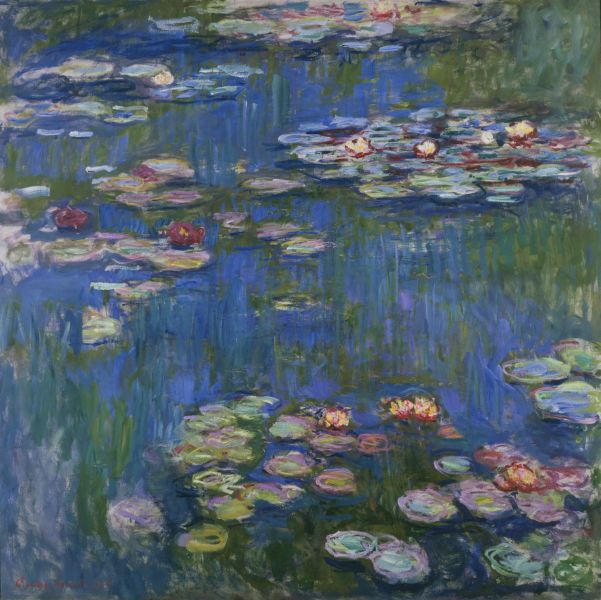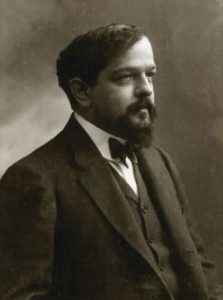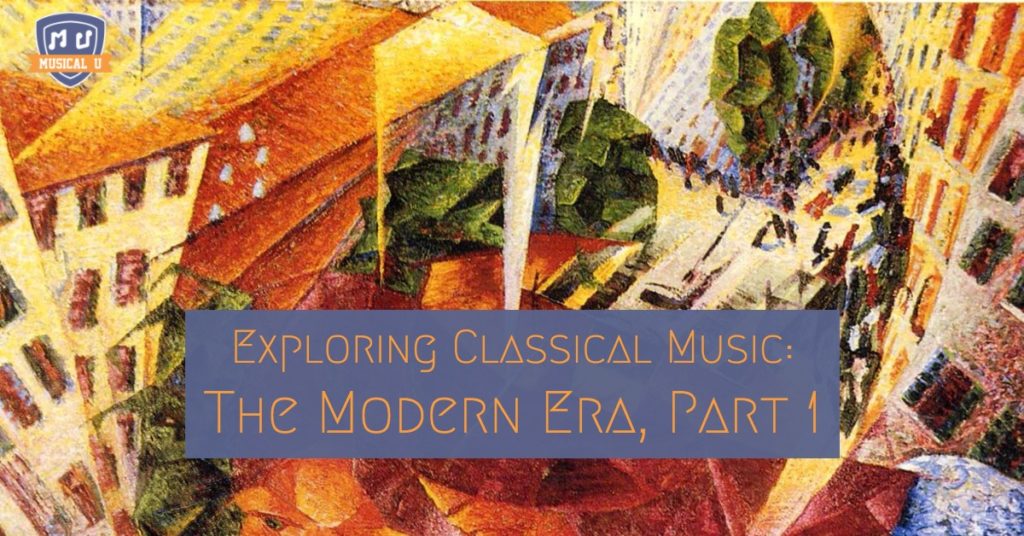The history of Western classical music responds to the thoughts and movements of the people that created it. In the Renaissance (1450-1600), classical music was mostly the province of the church and the nobility. The Baroque period (1600-1750) saw a restless expansion of European thought, technology, and territory. The Classical Era (1750-1820) reflected the Age of Reason’s love of form and structure. As the European aristocracy weakened its hold on the economic reigns, the Romantic composers of the 1800s became entrepreneurs catering to a middle class love of sensation, exoticism, and the supernatural.
The years that followed saw global change on unprecedented levels.These decades from 1890 to 1945 fit neatly under the umbrella term “modernism” and encompass critical global transitions like two World Wars, the development of Communism, and the emergence of new technologies, all of which profoundly affected artists and cultural production.
 Modernism
Modernism
Modernism can be thought of as the “engine” behind the aesthetic divide that surfaced between the last decades of the 1800s and the first of the 1900s. Operating on a variety of contrasting platforms, modernism pushed on through 1945, when an obligation toward avant-garde processes and outcomes, as well as exploration of exciting (and disruptive) new technologies, would take over.
The modernist era gave composers license to reject old ideas (like tonality and traditional forms) and to re-shape techniques. As life was disturbed by war and economic constraints, artists in turn disrupted traditional creative processes, turning to cutting-edge (and often very personal) ideas. The era of modernism thus brought with it a lack of any “collective” artistic pursuit; instead of group initiatives, assorted trends emerged, often in the hands a single artist and understood as a series of concurrent and conflicting “-isms”.
Here we consider the pairing of impressionism with Claude Debussy and expressionism to Arnold Schoenberg, as well as eclecticism as it played out in the music of Charles Ives, and the connection of neoclassicism to Igor Stravinsky.
Any discussion of these broad trends can be further explained by actions and responses related to rejection and opposition: some German composers rejected the major and minor scales toward music that was atonal – and thus unequivocally innovative. With political and social conflicts brewing across the globe, certain artistic outcomes aligned with nationalism. For example, the French vehemently opposed (and sought to differentiate from) the prevailing German aesthetic.
Consider, too, the concepts of reinterpretation and reinvention (typical of any modern-minded “renovation,” artistic or otherwise), where a “neo”-classical composer explored techniques of the past shaped by a new awareness and fresh processes.
A Progression of Trends
To situate composers and trends, it’s helpful to break this time span into sub-periods. 1900-1914 proved a time of open experimentalism; post-World War I and through the 1920s saw a tempering of that experimentalism, due in part to censorship and suppression (in some places, like the emerging Soviet Union). A distinct return to the past via neoclassicism persisted in various regions from the late 1920s through World War II.
Other composers reinterpreted “concert-hall” music by merging the popular with “classical” ideals. Leonard Bernstein and George Gershwin, for example, bridged divergent experiences and audiences by tucking elements like jazzy syncopation and micro-tones into traditional genres like the concerto, symphony, or even opera:
The “Emancipation of the Dissonance”
In terms of style, the biggest “disruption” was a deliberate rejection of tonality on the part of many composers – to the extent that the resulting music was atonal, without key center. Some also sensed that certain forms (sonata form, for example) had outlived their usefulness and thus structured musical materials in more loosely conceived structures, often relying on extra-musical associations for organization.
New Rhythms
Rhythmic innovations make modernist music particularly exciting: composers celebrated a reduction in metrical regularity, sometimes admitting to inspiration from music from far-off places (artists in Paris, for example, were fascinated by an American export known as “jazz”):
This awareness of global rhythmic options was heightened via new accessibility stemming from developments in recording and broadcast technologies.
Composer and Audience
Certainly not all of these new-age sound phenomena met with open minds and ears, and the gulf between composer and consuming public widened. Where composers had previously catered to the tastes of church, noble patrons, or popular audiences, 20th century composers often found refuge in the rarified halls of academia, producing a correspondingly intellectualized music.
It would take new efforts at reconciliation and more work on the part of listeners for this modern music to find its footing and its following. Still today, the modernist music written 100 years and more ago challenges the listener.
The ultimate name of the listening game here is an open mind: try to release any and all expectations. Experience this music just as the creator would have wanted—openly and honestly: use the collection of sounds to your own means and ends toward a personal assessment and interpretation.
“Clair de lune”
Claude Debussy (1862-1918) wrote his three-piece “Suite bergamasque” in 1890, and no. 3 is the famous character piece “Clair de lune” (Moonlight). It is a prime sample of impressionism in music, representing the peculiarly French artistic notion exercised by painters, writers, and composers who sought creative “distance” from German contemporaries.

Impressionistic music boasts some key traits like vague metrical pulse and imprecise forms, along with obscured tonality. “Clair de lune” is structured in a loosely conceived ABA form, stating the opening theme then traversing through a contrasting B section before returning to the familiar A content for balance.
 Things begin at a soft dynamic level, but the features of the opening phrases still impress into the ear and mind: it’s a neighbor-tone motive that makes this melodic idea stick. A neighbor tone is just what it sounds like: pitches are arranged to toggle away and then back to the starting pitch – in this case F to E flat, then back to F. Debussy sequences that same melodic contour down by whole step (so E flat to D flat, back to E flat), then down once again; listen from [0:00-0:20] to get a feel for this important foundational theme.
Things begin at a soft dynamic level, but the features of the opening phrases still impress into the ear and mind: it’s a neighbor-tone motive that makes this melodic idea stick. A neighbor tone is just what it sounds like: pitches are arranged to toggle away and then back to the starting pitch – in this case F to E flat, then back to F. Debussy sequences that same melodic contour down by whole step (so E flat to D flat, back to E flat), then down once again; listen from [0:00-0:20] to get a feel for this important foundational theme.
The piece is marked 9/8, but the beat pattern makes sort of leisurely transitions across barlines; in other words, you might not feel able to count an exact 1-2-3. Listen in the opening measures to how the left hand sounds on the downbeat, then the right hand takes off on the “and,” or the half-beat. That restless syncopation is what obscures the meter, a trait aligned directly with impressionism.
By [0:30], the texture has thickened because octaves “layer” in to the neighbor-tone motive. Simultaneously, Debussy exploits the piano’s lower range. By [0:49], the piece moves into a section marked tempo rubato (literally “robbed tempo”), giving the pianist interpretative room to breathe, to stretch phrases or slow down for dramatic force. At [0:56] comes a cumulative passage, where the right hand gains urgency and accelerates into the culmination of the first A section (around [1:16]), marked by four lush, rolled chords.
The B section begins at [1:23]. Listen for a transfer of melodic movement to the left hand: those more active arpeggios now underpin a languid right-hand melody. The sweeping motion of the broken chords builds across a gradual accelerando and dynamic shifts, then finally quiets at [2:10-2:20]. Be ready at [2:24] for the second A section of this ternary A-B-A, as the neighbor-tone motive returns at [2:28]. Debussy softens things via waves of sound that thin, then thicken, then deplete again.
Throughout, you may conjure images of night time and moonlight. Programmatic music – music with extra-musical association – was part of the impressionist’s “tool box,” but don’t be preoccupied with sensing exact details. Overall, Debussy’s pianistic style (and that goes for composing and playing, since this clip is of Debussy himself playing, thanks to a piano roll preservation) encourages a listener to revel, as he did, in the colors of the instrument across its wide range and in its versatility of keyboard action and sustain and damper effects.
While bridging the turn of the late 1800s and the early 1900s, we recognize Debussy as the first 20th-century composer. His use of fragmented, rhythmically ambiguous motifs and juxtaposition of shifting blocks of sound that transcended tonality were widely admired and imitated: these compositional techniques inspired composers diverse as Stravinsky, Schoenberg, and Ives.
But while Debussy’s popularity continues until today, later composers took the experimental tendencies of his compositional technique much farther, sometimes challenging their audiences to the point of violence – as recounted in the BBC movie Riot at the Rite. Next time we’ll wrap our ears around more of these modernist masterpieces. While you’re waiting, step on in to the moonlight as the sun set on the Romantic era and enjoy the sensual and other-worldly experience of a Debussy playlist.







